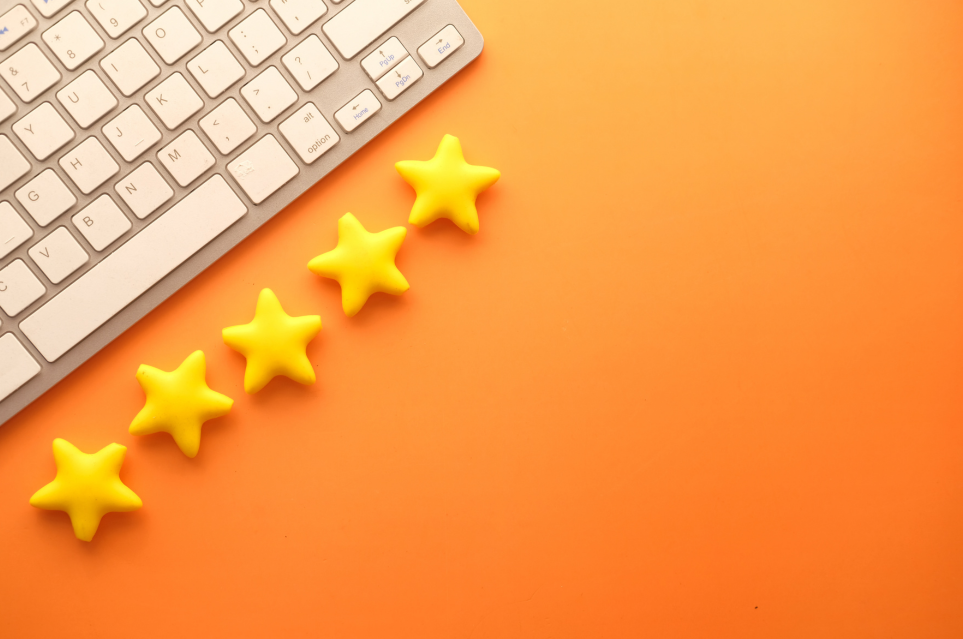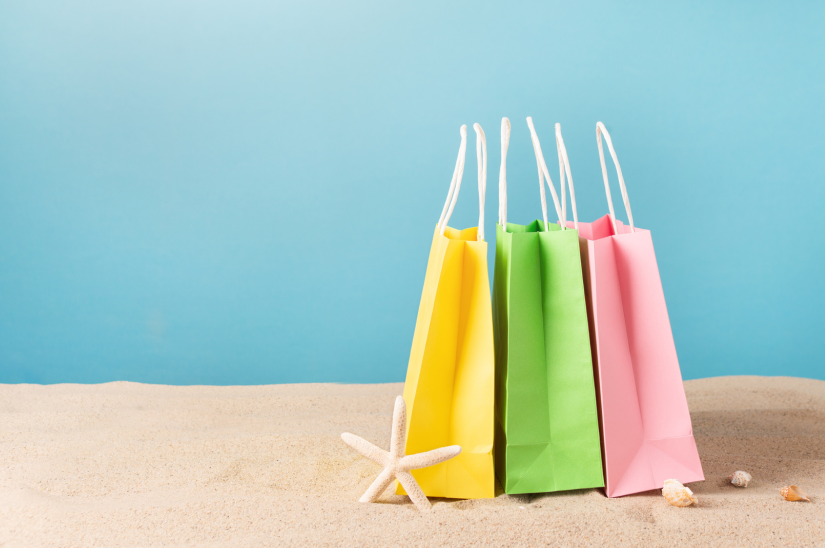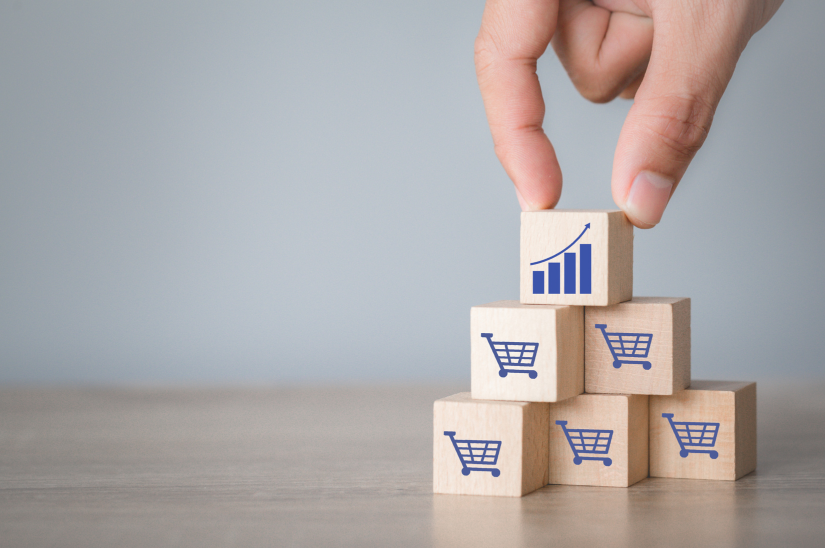Why is online customer experience more important than ever?
Online customer experience determines the success of your business. If you’re an e-tailer, you know that a single mistake can be enough to drive a buyer away. In fact, almost 85% of consumers stop buying after a bad online shopping experience. If you haven’t already done so, it’s high time to optimize your digital customer journey, especially in a post-Covid context where buying habits have changed for good. Before the health crisis, online shoppers focused on price and speed of delivery. Today, 61% of consumers¹ rank the quality of customer service as the most important factor in their purchasing decisions. What does this prove? That the customer experience is now a powerful sales lever. If you don’t optimize it, you run the risk of missing out on sales and just as many customers. So, what are the new codes of online customer experience? And above all, how can you integrate them into your e-commerce business? Let’s find out
Online vs. in-store customer experience: what are the differences?
Customer experience (CX) is the overall perception a buyer has of your brand throughout their interaction with your store. In a physical outlet, this experience is based on tangible elements: welcome, human contact, advice, ambience or product testing. On the web, however, it’s all done through digital interfaces and virtual interactions, which profoundly changes the game. Online, this physical contact doesn’t exist, which can make the shopping experience impersonal, and this is all the more the case on marketplaces due to the uniformity of stores. As an e-tailer, your challenge is to compensate for this lack of direct contact with a fluid, reassuring and engaging user experience. Today’s buyers expect :
- Clear information.
- Fast exchanges.
- Personalized options.
- A fluid user interface, from landing page to checkout.
Please note: each channel has its strengths and limitations. A physical store offers direct contact, while an e-commerce platform offers greater freedom and immediacy. A store is also limited by its opening hours, logistical constraints and queues, whereas an online presence guarantees 24/7 access.
Why is it essential to optimize your online customer experience?
E-commerce customer experience, or marketplace customer experience, is not just about satisfying a one-off need: it has a tangible impact on your long-term sales performance. In fact, 86% of shoppers are willing to pay more for an excellent online customer experience². What’s more, a satisfied customer is a loyal customer, and that makes a real difference to your sales performance. A study by Harvard Business Review³ proves it: a 5% increase in the loyalty rate can generate up to 95% additional profits.
When there’s no physical contact, the website or marketplace becomes the only point of interaction with the buyer. So everything must inspire confidence. This means careful visuals, authentic customer reviews, smooth navigation, clear delivery times and accessible customer service. If you can do this, here’s what you’ll achieve:
- Better conversion and fewer shopping cart abandonments.
- Improved customer loyalty and higher average shopping basket.
- Positive word-of-mouth, with more reviews, recommendations and ratings on the platform.
- Enhanced visibility, especially if you’re present on a marketplace like Rakuten, where your Merchant Quality Score influences the placement of your products on the BuyBox.
Note: customer demands have evolved. They now want responsiveness, clarity and control at every stage of the buying journey
What are the trends in online customer experience?
In e-commerce,customer experience doesn’t follow a single model. To stay competitive, you need to know your customers inside out. Remember that expectations can vary according to :
- The type of customer (persona): a young urbanite in a hurry, a housewife, a retiree or a high-tech equipment enthusiast do not have the same expectations.
- Type of product: a ready-to-wear purchase does not require the same level of reassurance as the purchase of a luxury item.
- Time of purchase: during certain periods, such as sales, customers may accept longer delivery times.
- Your brand image: the more upscale your brand is perceived to be, the more demanding the requirements.
Faced with this diversity of behaviors, you need to know your customer base inside and out, so you can continuously adjust your purchasing path. In 2025, you can rely on several innovations to upgrade your customer experience and stay competitive:
- Advanced personalization options: product, content or offer recommendations tailored to the customer’s profile and buying behavior.
- Omnichannel journey: offer a consistent experience across all channels (website, app, social networks, point of sale).
- Self-service customer service: with easy access to dynamic FAQs or help centers to resolve problems without human contact.
- Artificial Intelligence (AI): intelligent search engines, 24/7 chatbots and predictive analytics to anticipate needs.
While practical, these developments reflect a strong expectation on the part of consumers: greater simplicity, more autonomy and more responsive customer service, whatever the channel used.
Fragmentation of the purchasing path
The digital customer journey is now segmented into several stages. Indeed, a buyer may discover a product via an advert on Instagram, read reviews on a forum, compare prices on a marketplace, buy on another platform… then pick up their order at a pickup point or in-store. Your role in following this path is therefore to propose a navigation that is all the more fluid and intuitive, including:
- A clear user interface with visible CTAs.
- A high-performance search engine to find the right product quickly.
- Intelligent recommendations based on visitor behavior.
- A frictionless checkout: a sales tunnel with as few steps as possible.
Mobile at the heart of the online customer experience
Today, the mobile is the main point of entry in the customer journey. In fact, 74% of e-commerce purchases worldwide are made via smartphone⁴. And this figure continues to grow, particularly among buyers aged 18-35. To remain successful, your store must therefore offer an impeccable experience on mobile with :
- A responsive site or Progressive Web App (PWA).
- Fast loading, even with 4G.
- Navigation adapted to small screens.
- A simplified purchasing tunnel, with no unnecessary distractions.
Please note: With a poorly optimized site for mobile, you’ll miss out on many sales. With a few simple steps (content optimization, right image dimensions), you can already improve your mobile customer experience.
The importance of personalization in the online customer experience
What your buyers are looking for in 2025 is a tailor-made customer experience. That’s why personalizing your buying journey is essential today. Consumers want targeted messages, relevant suggestions and personalized shopping paths. They expect an experience that recognizes their preferences and rewards their loyalty. And unsurprisingly, it all starts with the very first navigation, with:
- Recommendations based on purchase history.
- Dynamic banners based on preferences.
- Email and push communications containing the customer’s first name, favorite items and tailored reminders.
- Personalized attention for loyal customers (birthday coupons, loyalty program rewards, exclusive offers on favorite categories, etc.).

Note: you can easily implement these actions by exploiting your customer data (cookies, purchase history, browsing, abandoned baskets…). But there are limits to what you can do. Only collect useful data, systematically ask for your customers’ consent before soliciting them (GDPR requirement) and always leave the user in control of what they receive.
A well-thought-out and properly implemented strategy is capable of significantly improving customer satisfaction and generating more repeat purchases.
How does AI affect the customer experience?
In 2025, artificial intelligence will add a new dimension to theonline customer experience. Its role: to intervene at every stage of the customer journey, with, for example:
- Intelligent search engines that suggest the right items even with approximate queries.
- Predictive AI that anticipates a customer’s needs and suggests the right offers at the right time.
- Automated data cleansing and segmentation by AI directly in your CRM, for more targeted and effective campaigns.
On the customer service side, AI complements the human and takes over many tasks. An intelligent chatbot can handle simple questions 24/7, freeing up your teams for more complex cases. In practice, an AI-assisted agent receives a summary of the customer file before even taking over, saving precious time

The benefits for your store are many: constant availability, faster service and large-scale customization. But be aware of AI’s limits:
- Risk of dehumanization if AI completely replaces human contact.
- Importance of transparency: always inform your customers that they are interacting with a bot.
- Management of sensitive data: the data collected and used by your AI assistants must remain GDPR-compliant.
Rakuten France’s conviction is that AI is indeed a strategic asset, but this tool must always remain at the service of humans, and work in tandem with real e-commerce experts.
As you can see, today, the online customer experience is a strategic lever that constitutes much more than a simple marketing asset. Whether you’re a seller on the Rakuten marketplace or an independent e-tailer, you have the means to act on every step of the journey to transform the purchase into a relationship. Make the most of it!
Sources:
¹Qualtrics, Top consumer experience trends for 2024
²Alma, Expérience client e-commerce
³Harvard Business Review, E-loyalty: your secret weapon on the web
⁴ Fevad, Les chiffres sur le mobile commerce
Rakuten France launches "Grand déballage", an immersive videocast that takes a different approach to e-commerce
Paris, April 10 - Why do we buy what we buy? How do our objects tell us about our relationship with consumption and society? Rakuten France is launching "Grand Déballage", an original videocast in which experts and researchers analyze major e-commerce trends through theunboxing of emblematic objects. The first episode on the home and its role in our lives is available now, and features two guests: anthropologist Dominique Desjeux and home psychology consultant Audrey Cassilda.

Unboxing: when objects tell the e-commerce story
"Grand Déballage" is based on a universal e-commerce ritual:unboxing. The moment when a parcel is opened, that box synonymous with excitement and discovery, is here hijacked to become a pretext for analysis and exchange. Behind each carefully chosen object lies a story, a social phenomenon, a consumer trend.
The idea? Each new episode tackles a major e-commerce trend: purchasing power, inclusive digitalization, the circular economy, the impact of technology, brand perception... To explore it, renowned guests, experts in various disciplines (sociology, anthropology, design, economics, etc.), lend themselves to the game: guessing and analyzing live a selection of objects that illustrate and fuel the discussion. A folding smartphone, a vintage handbag or a 3D printer... all bear witness to the evolution of commerce and our consumption patterns.
At the helm, Romain Roy, Sales Director at Rakuten France, moderates the exchanges and questions points of view, while sharing his expert insight into the evolutions and consumer trends observed by Rakuten France. Designed as a lively, interactive immersion, the videocast leaves room for anecdotes, surprises and on-the-spot reactions from the guests.
With "Grand Déballage", Rakuten France offers a different way of deciphering e-commerce. The aim is to make the major transformations in commerce and consumption accessible, by anchoring them in concrete objects that speak to everyone.
Episode 1: The home, a reflection of ourselves?
As the first living space, a refuge, a place of work or expression, the home is a strong marker of our relationship with consumption and identity. How has it evolved over the centuries? How has the home become a hybrid space, somewhere between comfort and work? How do our purchases shape our daily lives?

In this first episode, Dominique Desjeux, an anthropologist specializing in lifestyles and habitat, and Audrey Cassilda, a consultant in habitat psychology and founder of the École de la Déco Consciente®, combine their views to explore the central place of the home in our lives. While Dominique Desjeux provides an anthropological reading of the evolution of the home, Audrey Cassilda discusses the furnishing trends observed among her customers, and the symbolic role of objects in the construction of an interior in one's own image.
Together, they discuss :
- The history of living spaces and their evolution, from prehistoric shelters to ultra-connected interiors;
- The role of objects in the construction of our identity: memories, decoration, technological innovations;
- Major e-commerce trends related to the home: furnishings, connected objects, teleworking and sustainability.
Episode 1 is available today, Thursday April 10, on platforms including Youtube, Spotify, Deezer and Apple Podcasts.
https://youtube.com/playlist?list=PL2o_UuOxH8TKSRtOpVF9QAmR18FC0hJ99&si=VisEhEktsU_sV7_G
Energy label: your new asset for selling more on marketplaces
Have you prepared your energy labels for June 20, 2025? From this date, a new European regulation will make it compulsory for smartphones and tablets to display energy labels, espacially on marketplaces. But beyond the legal obligation, this information is also a key purchasing driver for consumers, who are increasingly sensitive to their environmental impact and to controlling their energy consumption.
In this article, we will examine :
- What is the Energy Label?
- Why it’s becoming essential to your business
- How to make the most of it and optimize your product sheets?
- How to attract eco-responsible customers
What is the energy label and how does it work?
The energy label is provides information to consumers about a product’s energy performance on a scale generally ranging from A (very energy-efficient) to G (energy-intensive). The products concerned by this new obligation are smartphones, tablets and, in some cases, other electronic equipment, depending on the evolution of European regulations.
The label also considers several product attributes. For example, an A-rated smartphone will have better autonomy and lower consumption than an E-rated smartphone. Similarly, a B-rated tablet will be more shock-resistant and easier to repair than an F-rated model.
What’s more, each label displays a number of criteria that go beyond energy consumption:
- Battery life.
- Drop resistance.
- Ease of repair.
- Service life.
- Protection against water and dust.
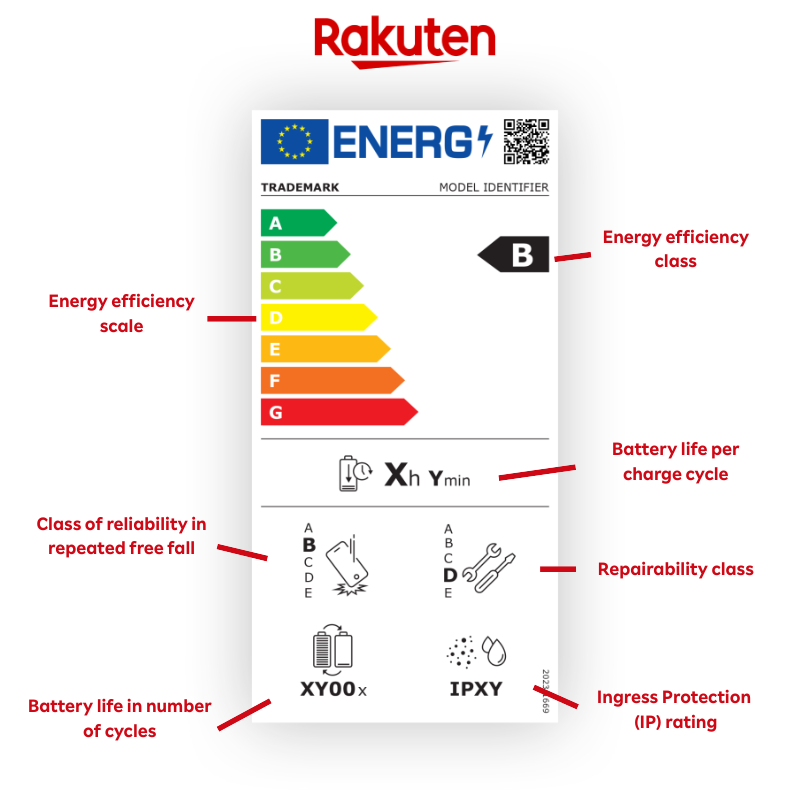
Why is the energy label essential on marketplaces?
According to a recent survey, 70% of French online shoppers prefer environmentally friendly products ². What’s more, the steady rise in electricity prices (50% on average in Europe over the last 5 years) is also increasing the attention paid to the energy consumption of appliances. Thanks to the energy label, consumers can make better choices, enabling them to:
- Save money;
- Reduce their environmental impact;
- Encourage the purchase of repairable and more durable products.
Good to know: professionals who fail to display this information by June 20, 2025, run the risk of sanctions, as compliance with the new standards will be monitored by marketplaces and the authorities. What’s more, over and above the obligation, the energy label is also a marketing asset to be exploited: in fact, a brand that promotes transparency and eco-responsibility increases customer loyalty.
Do you see this development as a challenge? Rakuten is committed to working alongside e-tailers to help you make this transition with complete peace of mind. In fact, our platform is actively working for more sustainable and responsible e-commerce. Here are just a few of the many advantages that Rakuten offers to support your sustainable development:
- A team dedicated to verifying the conformity of products on the marketplace.
- The signature of a commitment charter to reduce the environmental impact of e-commerce ³.
- Active promotion of second-hand goods, with over 50 million second-hand items available.
How can you highlight the energy label of your products on your marketplace?
To grow your business in the world of e-commerce, you need to succeed in capturing the attention and inspiring the confidence of buyers. To do this, you need to optimize your product sheets and take care with the presentation of the energy label. Here are a few practical tips to help you do just that:
- Include the energy label in the photo gallery of your product sheets.
- Detail key information in the description:
- Energy class (e.g. B)
- Battery life (e.g. 30 hours in standard use)
- Shock resistance (e.g. certified for 50 drops)
- Repairability (e.g. easy-to-replace battery)
- Protection against dust and water (e.g. IP68)
Check your compliance by ensuring that all data corresponds to the criteria required by the new regulations.
There’s no doubt about it: with a well-presented product and clear, accurate information, you’ll increase buyer confidence and improve your conversion rate.
How can you attract more eco-responsible customers to your online store?
Given the pressure of competition, it’s no longer enough to have a good product to attract an increasingly committed clientele. What you need to do is take a stand and make your values clear. If that’s what you’re aiming for, here are a few effective avenues to explore alongside the energy label:
- Highlight your commitment to the environment, for example, by mentioning your initiatives to reduce your carbon footprint.
- Offer sustainable products by favoring repairable, reconditioned or recycled materials.
- Rely on true transparency by clearly indicating warranty periods, repairability and your quality commitments.
- Use engaging marketing messages with taglines like :
- “Do your bit for the planet with this energy-efficient product.”
- “Opt for a sustainable and responsible appliance.”
Ultimately, displaying a compliant energy label is also an excellent way of reassuring and convincing environmentally conscious buyers. Don’t hesitate any longer, and get a head start on the market!
E-commerce Seller: How to Succeed in Your 2025 Summer Sales
The 2025 summer sales kick off on Wednesday June 25 and run until Tuesday July 22. For all e-tailers, this period, governed by summer sales regulations, is a highlight in the sales calendar. It’s an opportunity to boost sales, build customer loyalty and attract new buyers. It’s a key moment when consumers are equipping themselves for vacations, outfitting their exteriors or renewing their wardrobes. Certain categories benefit particularly from this seasonal dynamic: fashion, garden, home, leisure, high-tech and travel equipment. Good news: you still have a few weeks to prepare for the 2025 summer sales. Take the opportunity to get a head start, as competition is even fiercer at this time of year
Summer sales, a decisive moment for your e-commerce sales
Online summer sales are always eagerly awaited, and for you they represent a tremendous opportunity for growth. In France, 54% of consumers plan to buy during the sales¹. Unlike other online promotional events such as Black Friday or flash promotions, which last 24 hours or just a few days, summer sales are spread over several weeks. They also involve many more items. And several other factors reinforce the commercial potential of summer sales:
- An active clientele, in search of bargains and more inclined to buy during this period.
- Higher average shopping baskets: consumers take advantage of discounts to treat themselves to products they might not normally have considered, especially higher-end items.
- Increased prominence on marketplaces: during sales, platforms like Rakuten adapt their interface, deploy dedicated banners, send out targeted CRM campaigns and offer special operations (boosted cashback, exclusive coupons, product prominence). These key marketing actions enable you to gain visibility without any extra effort on your part.
Good to know: summer sales are also an opportunity to sell off your end-of-collection or surplus stock. These products are more likely to be snapped up when consumers are eagerly awaiting promotions.
Five tips for a successful summer sale
A successful summer sale can’t be improvised. What you need is a powerful, properly deployed strategy to optimize your sales and reinforce your brand image.
Anticipate your catalog and prices
Thorough preparation is the key to a successful operation. First step: analyze your market by identifying trendy products in your category. Use tools like Google Trends to spot seasonal expectations. Next, compare your offers with those of your competitors. For example, if you sell garden furniture, target the models most in demand during previous summer periods.
Next step: set strategic prices. Don’t sell at a loss, but offer attractive discounts while preserving your margins. Adapt discounts according to stock levels. Your best prices should be on the most popular items, or on unsold items that need to be disposed of.
Finally, be proactive in your communications. Plan key moments by creating a promotional calendar: launch, relaunch, last markdown. This organization enables you to align your e-mailings, visuals and publications with your customers’ expectations.
Good to know: if you sell on Rakuten, your dedicated E-Commerce Consultant can provide you with a list of products to highlight, advise you on pricing and support you in your communications. Don’t hesitate to ask!
Choose the best promotions
Your promotional mechanics must be clear, attractive and well thought-out. Your goal: to capture consumers’ attention. The important thing is to choose the right lever at the right time, and with this in mind, two formats stand out:
- Discount coupons, with limited duration or in restricted quantities, to play on scarcity and create a sense of urgency that generates sales.
- A temporary increase in cashback to encourage purchases while building loyalty.
Adapt your customer service to sales
During the summer sales, customer inquiries multiply: product information, order tracking or returns… More than ever, your e-commerce customer service must be ready. The right strategy: train your teams on products, delivery conditions and refund procedures. Once they’re up to speed, they’ll respond faster and more accurately. Another option: rely on tools to automate responses to recurring questions: chatbots, help centers or contact forms. Properly designed, they can absorb a large proportion of the flow of requests.
Let’s take the example of a shoe retailer: during sales periods, returns due to size errors are more frequent. By anticipating this problem with a clear size guide, a reassuring confirmation e-mail and a simplified returns procedure, you can significantly improve the customer experience.
Optimize inventories and deliveries
During the sales season, order volumes increase. That’s why your e-commerce logistics and inventory management need to run smoothly. To avoid delays or stock-outs, make sure you secure every step of the way:
- Order preparation: packaging, labeling and handling to handle large volumes quickly, everything must be ready.
- Maintain delivery times, even in busy periods.
- Reliability of carriers, thanks to trusted partners who ensure regular, trouble-free service.
- Management of product returns. Please note: returns are often more numerous during sales periods.
To meet this challenge, outsourcing your delivery management can be an excellent option. Rakuten Fulfillment Network, for example, takes care of all your e-commerce logistics. With RFN, you benefit from :
- Secure storage of your goods in partner warehouses.
- A high-performance logistics partner to ensure rapid preparation and dispatch of your orders.
- Reduced costs and mental workload during sales.
When you entrust your shipments to RFN, you save time so you can concentrate on what really matters: selling
How to optimize your traffic acquisition during the summer sales?
During the summer sales, it’s important to make good offers, but above all to ensure their visibility. Traffic doesn’t just happen: you have to generate it, amplify it and then convert it. Our advice: prepare a well-structured acquisition strategy as early as possible to capture attention at the right time, on the right channels.
Optimize your search engine optimization (SEO)
SEO stands for search engine optimization. It’s essential in e-commerce, especially during peak periods such as sales. An effective SEO strategy is built upstream, well in advance of commercial events such as sales. It’s not enough to add a few keywords at the last minute. It’s about structuring your entire site to enhance its visibility over the long term: not just the product pages, but also the “About”, “Contact”, legal and main category pages. Here are a few tips for improving your site:
- Update all your content, especially your product sheets, with targeted queries such as “2025 summer sales”, “garden promotions” or “women’s fashion bargains”.
- Create a dedicated sales page, well structured and easily accessible from your home page or menu.
- Optimize your title tags and meta descriptions to capture attention and generate more clicks from search results.
Many e-tailers would like to increase their visibility without mobilizing major technical resources. Integrating a marketplace can be an effective solution. At Rakuten, for example, a dedicated SEO team continuously improves content, page structure and product data. As a result, the platform attracts over 15 million unique visitors every month – a superb opportunity to improve your visibility.
Expand your communication channels
Your traditional communication tools are powerful assets for generating traffic and strengthening customer engagement:
- E-mailing remains one of the most effective channels. Plan a series of campaigns before, during and at the end of the sales. Segment your audiences to personalize your messages according to their buying behavior.
- Social networks are essential for relaying your offers: static publications, stories, reels or sponsored videos… anything goes to generate interest. Be careful: keep your graphic charter consistent, but specific to sales.
- Your e-commerce site or marketplace store should reflect the spirit of the sales right from the home page: banners, countdowns, filters by promotion… Highlight discounts where buying decisions are made.
Good to know: on a marketplace like Rakuten, these efforts are partly mutualized. You can use banners, dedicated e-mails and web push campaigns sent to millions of potential buyers. As a result, you benefit from enhanced visibility without having to deploy a complex strategy yourself. It saves you time
Generate traffic with advertising campaigns
Paid campaigns provide immediate visibility. Here are three tips for successful advertising during the sales season:
- Choose the right channels for your target. Google Ads helps capture purchase intent. Influencer partnerships or video formats on Instagram or TikTok, meanwhile, allow you to showcase your products in a more inspiring way.
- Anticipate your budget and schedule. The best campaigns are those that have been thought through in advance: analyzing competitors, setting objectives, testing messages before the official launch of the sales.
- Optimize your performance as you go along. Follow your campaigns in real time: adjust audiences, adapt visuals, carry out A/B tests. Every detail can make a difference.
Join a marketplace for a successful summer sale
If you’re not yet present on a marketplace like Rakuten, now’s the time to take the plunge. Our strength: a committed buyer base that’s particularly active during peak shopping periods. Rakuten attracts over 15 million unique visitors every month. In addition to being highly anticipated, summer sales are prepared and promoted. Unlike an isolated e-commerce site, a store on Rakuten benefits from shared advertising campaigns, powerful visibility tools (cashback, coupons, banners, etc.) and a volume effect that only a major player can offer. This channel is a powerful lever for attracting new customers, generating sales and promoting your products in a secure environment. Creating your online store on Rakuten is fast, intuitive and you benefit from the support of our teams. With integrated logistics solutions, dedicated technical support and a simplified interface for managing your products and campaigns, everything is within your reach! So don’t let this opportunity pass you by: get started today and be ready for June 25
Sources :
E-Commerce: How to Sell Abroad?
With the rise of e-commerce and digital technologies, distance is no longer an obstacle for e-tailers. For thousands of e-commerce sites, selling abroad has become a strategic choice for reaching a wider customer base and accelerating growth. But international expansion can’t be improvised. To succeed, you need to be well prepared and apply an effective internationalization process. If you’re an e-tailer with this ambition, here are a few tips on how to sell abroad effectively and ensure your success.
Why sell abroad?
Internationalization opens up a whole new world of possibilities and offers many advantages to e-tailers who, like you, want to sell outside their own country. When you sell abroad, you increase your sales potential and diversify your sources of revenue.
Selling in another country also helps you build brand awareness and credibility.
A recent study clearly demonstrates this: sellers who export see their sales increase by an average of 30%¹. What’s more, certain product categories find a more receptive audience on the international market, which can encourage rapid expansion.
What are the risks of selling abroad?
Before you think about selling abroad, you need to have a well-established store in your own market. Indeed, international expansion involves costs and more complex management, which will generate certain challenges:
– Higher logistics and transport costs.
– Regulatory and customs barriers.
– Different customer expectations in different countries.
To sell abroad, your local business needs to be well-structured and time-efficient. Managing orders, inventory and customer service can quickly become complex when operating in several markets. A marketplace such as Rakuten is an ideal solution, as it centralizes these aspects on a single platform. It also makes it easier to put products on sale, update product sheets and manage customer relations. You benefit from a large, targeted customer base, as marketplaces generally have excellent search engine rankings. This means you can concentrate on your international expansion, while keeping your organization smooth and optimized. With Rakuten, you benefit from an e-commerce solution that offers you :
– Simplified management that frees up your time to concentrate on your expansion.
– Low costs, with a Starter Pack at €0 and an Expert Pack at €49.
– Qualified traffic with 13 million members of Club R, France’s most generous e-commerce loyalty program.
Five tips to successfully sell abroad
Discover 5 essential steps to successful internationalization.
Identify the right countries
Not all markets are created equal. That’s why, before setting up a store to sell abroad, we recommend analyzing the potential of your products in your target countries. Here are a few criteria to consider:
– Ease of movement of goods and associated customs duties.
– Purchasing power and local consumer habits.
– Development of e-commerce in the target country.
For example, an e-commerce store selling organic products could very well sell its products in Germany. This is a country where demand for this type of product is very strong.
Work on your product catalog
Not all your products have a place abroad. Some brands are only known locally, and many products have a very cultural use.
Before putting all your products online abroad, you need to find out what consumer habits and product categories work best in your target country. It’s best to start with a limited catalog, then expand your offer once you’ve established a sound base and your store is starting to become known. For example, if you sell 10 different phone models in France, you can start by putting 1 or 2 of these models on sale, and adjust your offer according to their success.
Translate your content
Selling internationally also means adapting your product sheets and marketing materials. And you can’t just rely on machine translation. To guarantee an optimal user experience, you need to use language that is natural, accurate and culturally appropriate to your target audience. You also need to be rigorous about :
– Your e-commerce site is fully translated. Most e-commerce CMS offer free plugins to facilitate translation.
– Your product descriptions and advertising campaigns are localized.
– Your customer service can respond in the language of the target country.
Good to know: translating your content can also improve your site’s natural referencing in the target country, and therefore its visibility.
Find out about local regulations
Each country has its own rules to sell abroad. Outside the EU, consumer rights can differ greatly. Take the United States, for example. Return policies there are more flexible than in France, which can have an impact on your inventory management.
At the same time, you need to have a perfect command of :
- Legal status;
- VAT obligations;
- Product safety standards;
- Differences in consumer law.
Offer the right payment methods
While payment by credit card is often preferred by consumers in France, this is not the case everywhere. In Germany, for example, PayPal and bank transfers are widely used. So you need to offer the payment options most commonly chosen by customers in your target country.
You also need to think about currency conversion. To do this, you can opt for a solution that reduces exchange costs and simplifies the management of international payments. WorldFirst, for example, offers advantageous conversion rates and facilitates multi-currency transactions. This solution represents a real asset, enabling you to optimize your cash inflows and reduce losses linked to currency fluctuations.
Manage your logistics efficiently
Selling abroad means shipping further afield. This inevitably means longer delivery times and higher costs. Fortunately, you can easily optimize your shipments with a few simple tips such as :
– Use reliable carriers with suitable offers.
– Limit returns with clear product descriptions.
– Outsource your logistics to reduce lead times and costs.
To outsource your logistics, we recommend that you turn to a complete solution for managing your stocks and shipments. With a network of service providers and warehouses strategically located across Europe, Rakuten Fulfillment Network, for example, enables fast, efficient shipping to multiple markets. What’s more, its integrated system simplifies order management, reduces logistical errors and optimizes shipping costs. You have access to all orders from a single dashboard, and real-time alerts enable you to manage your stocks and deliveries more effectively. By freeing up time on your logistics, you can concentrate fully on your international growth and on what you do best: selling.
Finally, selling abroad is a fantastic opportunity to develop your e-commerce store. But to do so, you need to prepare for internationalization. By following the advice in this guide, you’ll maximize your chances of success. Today, joining a marketplace like Rakuten makes it easier for you to expand worldwide. It gives you access to a qualified audience while simplifying the management of your business. The world is at your fingertips. Get started
Sources :¹Fevad
E-Commerce: How to Manage your International Deliveries?
Today, one in three French e-tailers already sells its products abroad, and this figure is growing all the time! Both in Europe and abroad, there are numerous opportunities for brands looking to expand their market. But before you start selling abroad, you need to consider a number of parameters. From the choice of carrier to customs regulations and customer expectations, managing your international deliveries can seem complex. Fortunately, with the right preparation – and, above all, the right partners – this step can be transformed into a powerful growth lever
What are international deliveries ?
International deliveries refer to the shipment of parcels from one country to another. This includes shipments within the European Union, as well as to destinations outside the EU.
Unlike domestic deliveries, there are a number of factors to consider when selling abroad:
- Costs that vary according to geographic zone and shipping method.
- The importance of using adapted packages, whether in terms of labeling or the languages used.
- Strict customs regulations, depending on the goods being shipped and the country of destination.
- Payments in foreign currencies, which can impact your margins depending on exchange rates and conversion costs.
- Various modes of transport (road, sea or air) to choose from, depending on delivery times.
Let’s take the example of a French seller of natural cosmetics whose warehouse is in mainland France and who decides to launch in Germany. To send his parcels abroad, he must not only translate his shipping documents into German, but also ensure that his goods comply with local regulations. Labeling must also be rigorous to facilitate customs clearance and avoid any blockage during shipment.
How to manage your international deliveries successfully?
Every step counts when it comes to successful international deliveries, from the preparation of your parcel to its receipt by the customer. Here are the points to master to ensure smooth, professional shipping.
Preparing your parcels
Packing and wrapping your parcels is the first step in ensuring smooth international deliveries. To do this, you need to :
- Sturdy cardboard packaging.
- Protect fragile products with cushioning materials (kraft paper, foam, etc.).
- Adapt the size of the parcel to its contents, to avoid the extra cost of over-wrapping.
- Seal carefully with reinforced adhesive tape.
Labeling:
- Use the right barcodes and labels according to the weight and nature of the parcel. Check that your packing slips correspond to the correct postage.
- Respect country-specific address formats.
- Add an inner label with the international deliveries address (useful in case of external damage).
Example of a mailing label for Germany:
Herr Max Müller
Berliner Straße 12
12345 Berlin
Deutschland
Select the right carrier
Every international carrier offers different services. To avoid costly and time-consuming mistakes, you should compare different service providers and test several solutions before making a long-term commitment. Here are some points to consider:
- Shipping rates.
- Delivery method: home delivery, letterbox or locker delivery, collection point, etc.
- Delivery times.
- Geographic coverage
- Carrier’s reputation in target country.
- Quality of customer service.
- Carrier options and partners: express delivery, Mondial Relay or Colissimo parcel relays, etc.
Customs clearance
For all international deliveries outside the EU (or even within it in some cases), customs clearance can be a real headache: extra charges, products blocked at the border, regulations… To make customs clearance as straightforward as possible, it’s important to think ahead, especially when it comes to..:
- Prohibited, regulated or dangerous products in the destination country.
- Mandatory labelling (e.g. CE marking for certain equipment).
- Including customs charges in the final price, to avoid unpleasant surprises and protect your margins.
- Bulky parcels, which can quickly inflate shipping costs.
Anticipating the unexpected
Your international deliveries may encounter problems beyond your control: delays, loss, breakage… There are, however, solutions to prevent these problems:
- Take out parcel insurance adapted to the value of your products and the countries served.
- Set up a responsive customer service department capable of handling incidents efficiently.
- Provide your customers with a tracking number so they can easily follow the progress of their order.
Would you like our experts to help you with these issues?
Opting for a logistics provider for international deliveries
Outsourcing your logistics is an excellent solution for managing your deliveries abroad.
Calling on a specialized logistics provider allows you to :
- Save time: no need to manage individual shipments, your logistics partner takes care of them for you.
- Simplify operations: a single point of contact, even for several countries. Reduce superfluous exchanges and bonus: you manage your logistics in a single language
- Optimize costs: logistics service providers generally offer shared costs with other merchants and carriers. You benefit from competitive rates.
So you can concentrate on your core business and what you do best: selling.
Rakuten Fulfillment Network: an ally for your international deliveries
Rakuten Fulfillment Network (RFN) is a turnkey e-commerce logistics service designed to support your local and international development. Combining unique technology and responsive experts dedicated to your growth, this solution offers merchants :
- A network of warehouses across Europe;
- Trusted carriers;
- Pooled transport costs (up to 5 times cheaper than individual shipments), enabling you to offer competitive shipping rates;
- A centralized dashboard (with order management, real-time alerts and optimized tracking).
By choosing Rakuten Fulfillment Network, you offer yourself the peace of mind of controlled international logistics, with efficient overseas deliveries, optimized costs and a customer experience to match your ambitions. Take advantage!
Rakuten strengthens its technical presence in Europe with the opening of the Rakuten Tech Center Europe in Paris
Paris, April 17, 2025 - Rakuten Group, Inc. Announces the creation of the Rakuten Tech Center Europe, a new technology entity dedicated to promoting innovation, strengthening collaboration and consolidating the company's technological leadership in the European market. The center officially began operations on April 1, 2025, with a launch event held on April 16 at its offices in the heart of Paris.

A center of technological expertise at the heart of Europe
The Rakuten Tech Center Europe has established itself as a strategic hub for the region, bringing together a diverse and highly qualified team of over 50 employees. These experts work in a variety of fields, including artificial intelligence, data center management, cloud computing, platform development and IT support. The center also hosts members of the Rakuten Institute of Technology, the incubation center dedicated to AI and advanced technology research.
This center aims to support Rakuten's innovation initiatives both regionally and internationally. It occupies modern, state-of-the-art workspaces, co-located with Rakuten France teams, enabling optimal integration of innovative solutions into the company's European operations.
The management of Rakuten Tech Center Europe will be entrusted to a four-member supervisory committee: Naojiro Hisada, Executive Officer, Rakuten Group, Zoran Stejic, Head of Europe AI & Data, Fergal Downey, Fellow of Rakuten Group, and Kieran Lynch, Head of Europe Legal & Compliance. Zoran Stejic will also assume the role of President, ensuring the center's strategic direction and alignment with Rakuten's global vision for innovation.
Zoran Stejic, Head of Europe AI & Data and President of Rakuten Tech Center Europe, comments: "By establishing a center dedicated to technological excellence in the heart of Europe, we are reaffirming our commitment to advancing innovation and strengthening collaboration between our tech experts in the region. This center is designed to attract the best talent, to design and deploy innovative solutions capable of meeting the specific challenges of the European market - and beyond."
Thirteen years after the establishment of Rakuten's technology division in Europe, and with teams present in several European countries, the launch of the Rakuten Tech Center Europe marks a key milestone. It testifies to the company's ongoing commitment to investing in innovation to keep pace with the rapidly changing European technology landscape.
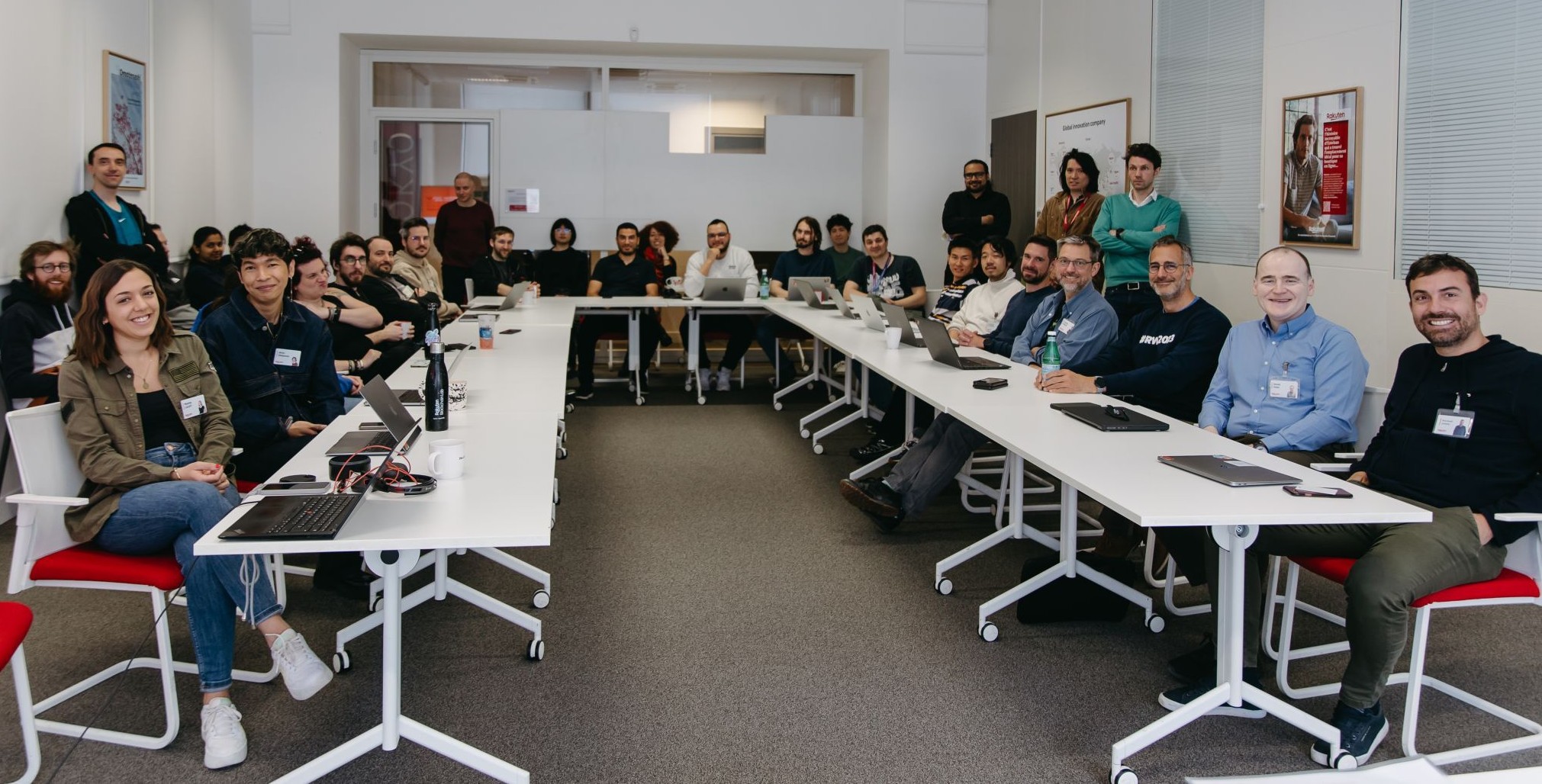
How to Diversify Your E-commerce Sales Channels?
Customer acquisition costs have risen by 60% over the last 5 years¹. In an ultra-competitive e-commerce market, where new players are constantly emerging and it’s getting harder and harder to stand out, multiplying the points of contact with your customers is essential.
In this article, find out how to diversify your sales channels to boost your sales and secure your market position.
Why is diversifying sales channels essential?
Relying on a single sales channel, whether it’s your physical boutique or your e-commerce site, is a bit like putting all your eggs in one basket. Risky, isn’t it? Here’s why it’s crucial to diversify your approach:
Reach a wider, more diverse customer base
The e-commerce market is constantly evolving, with the number of online shoppers growing daily. In France, 40 million people buy online every year², placing an average of 60 orders per person per year. It’s impossible to capture all these customers with a single store, however effective it may be. By diversifying your sales channels, you:
- Increase your online visibility and brand awareness;
- Reach customers with different characteristics: age, standard of living, buying habits…
Adapt to customer volatility
Today, a customer can leave your purchasing path in a single click to buy from a competitor. It’s hard to keep your customers loyal, because consumers are increasingly demanding and have a huge number of similar items at their fingertips. Relying solely on the clientele of a single channel is therefore a mistake. By multiplying your points of sale, you can compensate for shopping cart abandonment in one channel with customers from another.
Track changes in buying behavior
Purchasing behavior has changed radically in recent years. Customers are present on multiple sales channels: marketplaces, social networks, discount websites… It’s not unusual for a customer to pass through 3, 4 or more points of contact before finalizing an order.
Take Sophie, for example, who’s looking for a new phone. She sees a sponsored ad on Instagram for a new model. Preferring to buy refurbished models, she first looks at prices on eBay. The next day, she compares different models on a bargain site. In the end, she buys her phone on Rakuten, where she benefits from an attractive cashback offer. If you’re selling this phone, it’s in your interest to be present on each of these sales channels.
Avoid dependence on a single source of income
Dependence on a single sales channel can be risky. Has a Google algorithm change penalized your e-commerce site’s SEO? Does your favorite marketplace increase its commissions, or worse, close? These elements are beyond your control and can have disastrous consequences for a business centered on a single channel. Diversification is a resilience strategy that enables you to cope better with the unexpected.
How to set up a sales channel diversification strategy?
To successfully diversify your sales channels, you need to follow a few key steps:
- Define your objectives and target audience: How much sales do you want to achieve? Which customers do you want to reach?
- Choose the right channels for your business: Not all channels are suitable for all types of products. A platform like Etsy is ideal for selling your latest handcrafted creation, much less for new headphones.
- Adapt your offer and communication to each channel: Are you selling on a B2B marketplace? Adopt a neutral, professional tone. Selling via an affiliate link on Instagram? Opt for a more relaxed, human message, better suited to the platform’s codes.
- Measure and optimize your performance: Analyze results on each channel and adjust your strategy accordingly.
- Set up centralized sales management: Stocks, orders, deliveries… We recommend that you manage everything centrally to avoid errors and save time.
How do you manage your stocks, orders and deliveries across different channels?
Selling across multiple channels can quickly become a logistical headache. Fortunately, there are solutions to make your life easier. For efficient, centralized delivery management, consider a logistics service like Rakuten Fulfillment Network. With this type of solution, all your orders are centralized in a single dashboard, you can monitor your stock levels in real time and choose your delivery methods in just a few clicks. Bonus: 99% of orders are delivered within 24 hours. A considerable time-saver!
What are the best sales channels to use in e-commerce?
There are a multitude of e-commerce sales channels, each with its own advantages and disadvantages. The ideal is to use them in a complementary way to reach a varied clientele and maximize your revenues.
Your own e-commerce site
- Advantages: You have total control over your brand and the customer experience, which helps build loyalty. You choose the look and feel of your pages, the customer journey and the functionality of your site.
- Disadvantages : Developing and maintaining a website can be costly and requires specific expertise. You also need to have sufficient time and resources to manage search engine optimization (SEO) and traffic acquisition.
Specialized marketplaces
- Advantages: They enable you to target a specific audience and reach customers in a particular field.
- Disadvantages: The audience is smaller and commissions can be high.
- Examples: Etsy (crafts), Back Market (refurbished items).
Generalist marketplaces
- Advantages: They offer massive visibility and traffic without any effort on your part. On Rakuten, for example, 15 million unique visitors visit the platform every month. You can also reach customers outside your initial target, thanks to personalized suggestions on the platform: an excellent opportunity to generate additional sales.
- Disadvantages : Competition is strong, commissions can impact your margins, and you generally have less control over the customer experience.
- Examples of generalist platforms: Amazon, eBay, Rakuten.
It’s important to note that Rakuten differs from other generalist marketplaces in its non-competitive approach. We don’t sell our own products, but only act as an intermediary between buyers and sellers. As a result, all our resources are dedicated to our sellers, with a single objective: to help you sell more.
Social networks
- Advantages: They offer a high potential for engagement and virality, enabling you to create a direct relationship with your customers. What’s more, the buying process is more organic than on other platforms: your products are put in the spotlight
- Disadvantages : Competition is fierce, and you need to be able to free up enough time to federate your community. You also need to be aware of frequent changes in network strategy: new formats, algorithm changes, etc.
- Examples: Facebook Marketplace, Instagram Shopping.
Good deals sites
- Advantages: This type of community platform attracts qualified traffic looking for bargains. You don’t sell directly on these sites, but can redirect visitors to your products via an affiliate link. The key to these channels is to offer attractive deals.
- Disadvantages: Competition is intense and it can be difficult to match the often very low prices on offer. You also need to keep a constant watch to ensure that your offers are well promoted and remain competitive.
- Example: Dealabs, Radins.com.
Marketplace: an ideal solution for diversifying your sales channels
Did you know that 46% of consumers start their purchasing journey on a marketplace, and that 61% are more inclined to buy on a marketplace than on a retailer’s website³? For online shoppers, a marketplace has many advantages: access to a wide range of products in one place, low prices, promotional operations (sales, Black Friday)… Marketplaces are attracting more and more customers every year.
Advantages of a marketplace for a retailer
For a retailer, a marketplace also has a number of advantages:
- Traffic and brand awareness: marketplaces attract massive traffic. And traffic means sales opportunities. 15 million unique visitors visit Rakuten every month.
- Promotions and loyalty tools: marketplaces finance numerous promotional offers for sellers. Rakuten, for example, offers up to 20% cashback on all purchases on Mega Peak days, every first Wednesday of the month.
- Customer journeys and innovations: marketplaces generally have entire teams dedicated to optimizing customer journeys and integrating the latest technological innovations: chatbots, AI-supported search engines, optimized item suggestions… These are all essential but time-consuming elements that you don’t have to manage yourself.
- Complementary tools: Most marketplaces are complete ecosystems that offer numerous tools to optimize your business: advertising solutions, logistics services, retail media… At Rakuten, our solutions are integrated into a single dashboard. The objective? Develop your sales in just a few clicks.
As you can see, selling on a marketplace is an essential step towards diversifying your sales channels. All that remains is to choose the right platform for your needs.
Successful marketplace integration: Fnac-Darty group
Let’s take the example of the Fnac-Darty group, which integrated the Rakuten marketplace in 2023 to diversify its acquisition channels. The decision to join a marketplace was a response to the following challenges:
- Develop online sales in an ultra-competitive sector;
- Capitalize on Fnac-Darty’s physical network through Click and Collect;
- Offer concrete benefits to consumers (cashback, flexibility).
A year and a half later, the results are convincing:
- A customer satisfaction rate of 4.8/5 for Darty products;
- Over 50% of Darty customers on Rakuten are new or reactivated customers;
- The offer on Rakuten is complementary to that on the Darty.com site, so there has been no cannibalization of sales.
By joining a marketplace, the Fnac-Darty group has benefited from a new customer base, increased in-store sales thanks to Click and Collect, and taken advantage of Rakuten’s loyalty-building tools. A successful gamble!
Sources
¹Profitwell
³ChannelEngine
The "right" purchasing power
"Increasing purchasing power shouldn't come at any price. Respecting consumers must not prevent us from protecting producers and their margins, as well as the planet," reminds Cédric Dufour, CEO of Rakuten France and Rakuten TV. "The notions of disposable income, inflation and price are naturally central to meeting immediate needs, but this strictly quantitative approach obscures a fundamental dimension: that of quality."
The right price
"Good" purchasing power cannot be achieved at any price. It must be sustainable and based on partnership. Offering discounted prices is laudable, but if it means squeezing margins in a way that is unsustainable for certain players in the chain, it makes no sense, because it is not economically tenable.

Another approach, adopted by some e-commerce platforms is possible: to offer a "fair price", reducing intermediation costs to a minimum, but ensuring a fair distribution of value between all economic players. Thanks to this logic, retailers and brands can access consumers under fair conditions. Take the example of Black Friday, a ritual often disparaged, but which makes a major contribution to purchasing power, by enabling consumers to do their Christmas shopping at the best possible price. Promotions are often the result of a collective effort by the entire upstream chain. For example, when retailers offer "cashback", they themselves invest in purchasing power, by reducing their margins to lower the real price. The effort is thus shared to lower the price and make the sale happen, without crushing the seller's margin. Some consumers are thus able to buy products that would otherwise be inaccessible to them. It's a win-win situation: first and foremost for consumers and brands, but also in the long term for retailers, despite the many promotions they run."
Circularity and second-hand
"Good purchasing power is also based on an increasingly circular economy. The steady increase in second-hand goods, as we saw again with the resale of Christmas presents, is positive for the environment. All we're doing is passing on goods, without making the planet pay the high price of new every time. But it's also good for the wallet: all second-hand sales are in fact shared and collective purchasing power, enabling us to buy the things we need at a more advantageous price, and therefore to better respect our budget. It's a win-win situation that we absolutely must encourage."
Quality, sustainability guarantee
"Finally, good purchasing power means respecting the consumer. Buying new, like buying second-hand, must not be a bargain purchase, with no regard for the most basic guarantees. Unfortunately, "low cost" is all too often a low-quality purchase. Over and above the most elementary questions of product safety and respect for human rights during the manufacturing process, this is counterproductive, as it encourages repurchasing. Buying better quality means buying less regularly, as products last longer. Every purchase must also be accompanied by the possibility of refund or exchange, transaction security and a commitment to fight fraud and counterfeiting.
This is a real challenge for e-commerce platforms, but let's not lump them all together. While some non-European players are free from laws, regulations and tax constraints, many European platforms promote a model of trust. Let's bet that consumers won't be fooled.
Good purchasing power is not just about buying more, but buying better. It's based on a fair distribution of value within economic chains, and an awareness of environmental and quality issues. It's much more than an economic issue. It's a pressing social issue," says Cédric Dufour, CEO of Rakuten France and Rakuten TV.
By Cédric Dufour , CEO of Rakuten France and Rakuten TV
Source : Opinion column in Les Echos.
Rakuten France strengthens its commitment to responsible e-commerce by signing the new Charter of commitments to reduce the environmental impact of e-commerce
Paris, March 4, 2025 - By signing the new Charter of commitments to reduce the environmental impact of e-commerce, Rakuten France confirms its role as a leader committed to a sustainable transformation of the sector. This initiative is supported by Agnès Pannier-Runacher, Minister for Ecological Transition, and Véronique Louwagie, Minister Delegate for Trade, Craft Trades, small and medium-sized enterprises and the Social and Solidarity Economy. It sets ambitious targets for more environmentally-friendly e-commerce. Signed for the first time in 2021, this new version of the charter marks a decisive step towards structuring an eco-responsible approach to e-commerce.
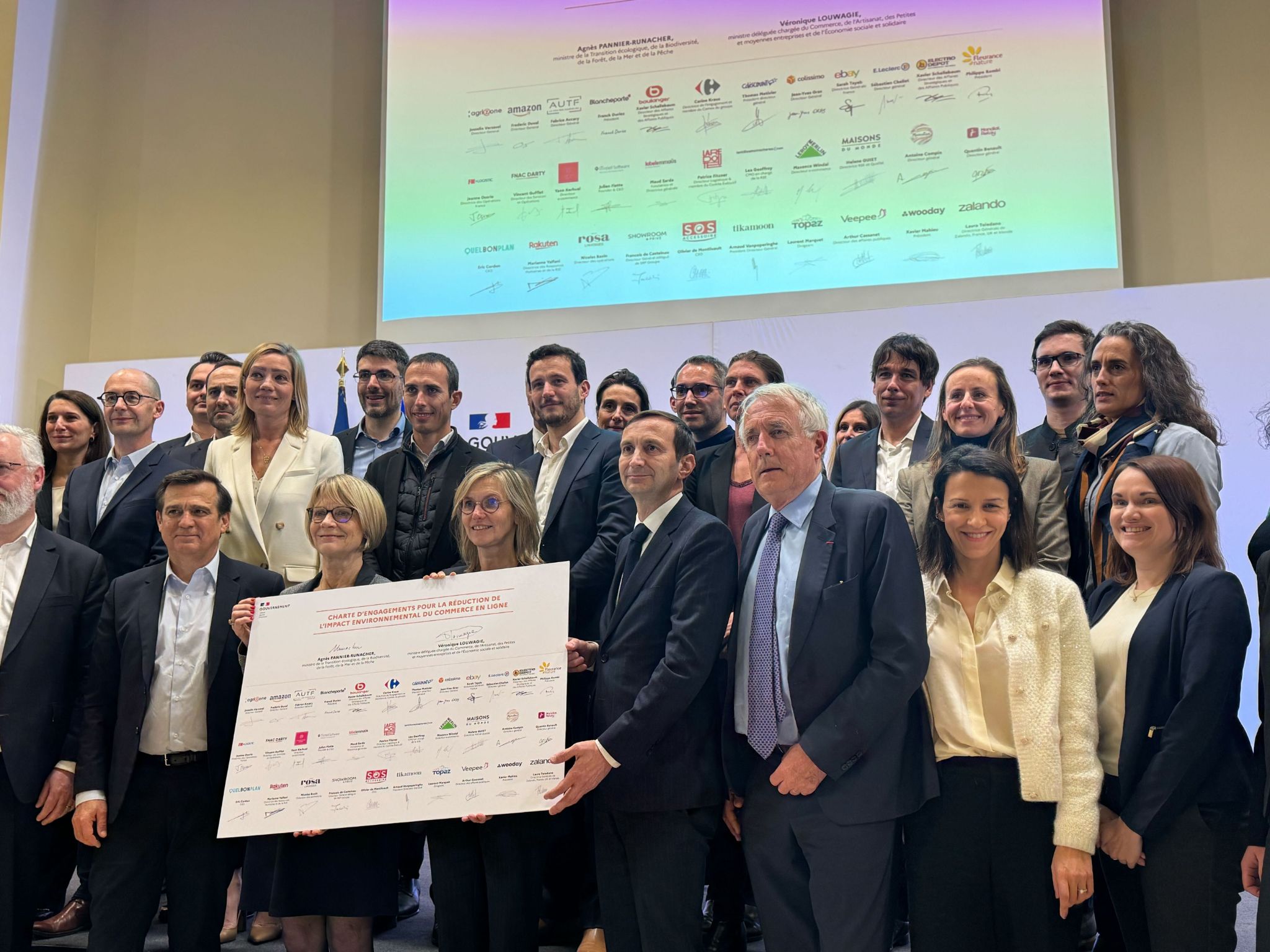 Marianne Yalfani, Human Resources Director, and Benjamin Moutte, Legal and Public Affairs Director at Rakuten France, on March 3, 2025, at the signing of the Charter of commitments to reduce the environmental impact of e-commerce.
Marianne Yalfani, Human Resources Director, and Benjamin Moutte, Legal and Public Affairs Director at Rakuten France, on March 3, 2025, at the signing of the Charter of commitments to reduce the environmental impact of e-commerce.
Rakuten France's new commitments take the form of a series of actions aimed at limiting the impact of consumption on the environment. The platform is committed to better informing consumers by highlighting a significant offer of local, sustainable and second-hand products. To encourage more responsible choices, specific tools are considered, such as filters facilitating the search for products with a low energy impact and better repairability.
In terms of logistics, Rakuten France will continue to promote eco-responsible delivery solutions, notably Click & Collect and point relais delivery, which help limit the carbon footprint associated with transport. Finally, we will be raising consumer awareness of the environmental impact of returns, by reducing the emphasis on free returns and communicating their ecological consequences, while respecting the right of withdrawal.
" The result of a shared vision between public authorities and e-commerce stakeholders, this charter aims to reconcile the sector's development with respect for the environment. At Rakuten France, we are aware about the role we can play in reducing the ecological footprint of online commerce. We will continue to innovate and collaborate with our partners to offer solutions in line with our customers' expectations and current and future ecological challenges, " says Cédric Dufour, CEO of Rakuten France and Rakuten TV.
A pioneer of second-hand goods in France, Rakuten France has placed the circular economy at the heart of its model since its creation. With over 50 million second-hand references available and one out of every two products sold second-hand, the platform contributes each year to avoiding the emission of 23,000 tons of CO₂. This commitment to more responsible e-commerce is reflected in concrete initiatives, such as the Reconditionné CeRtifié guarantee or Club R, which rewards its most loyal members with 10% cashback on second-hand purchases made from private sellers.
What is the best marketplace to sell online?
Do you want to develop your online business? Joining a marketplace is an effective solution for rapidly accessing a large audience and optimizing your sales. However, with the diversity of platforms available, choosing the one that best suits your business can prove complex.
Which marketplaces are best suited to sellers? What criteria need to be taken into account to make the right choice? This article will guide you through the process, with a comparison of the best marketplaces.
What is a marketplace?
A marketplace is a sales platform similar to a huge digital shopping mall. Inside, each store corresponds to a different brand. Merchants offer their products to all visitors to the platform, and benefit from a number of levers: loyalty program, personalized store, possibility of setting up discount coupons, etc.
Unlike an ecommerce site (Shopify or Woocommerce store, Wordpress site…), a marketplace brings together a large number of sellers. While your products are certainly in competition with others, the downside is that you benefit from very high traffic and cross-selling opportunities. Let’s take an example: you sell PS5 video games on Rakuten, but you don’t sell consoles. A customer decides to buy a PS5 console from another seller. When they finalize their purchase, your games will be suggested to them directly from the console’s product sheet, thanks to the intelligent suggestions generated by the platform. By selling on a marketplace, you can reach new customers and generate sales opportunities you wouldn’t have had otherwise.
A marketplace is therefore an online platform that facilitates contact between buyers and sellers, and acts as a trusted third party in distance selling.
Why choose a marketplace to sell online?
To sell online, you could set up an e-commerce site. Creating an online store has its advantages, but can quickly become costly and time-consuming: buying a domain name, choosing a CMS, site architecture, creating product sheets, installing plugins… All of these tasks take time away from your core business: selling. A growing number of e-tailers are turning to a more affordable e-commerce solution.
Selling your products via a marketplace offers many advantages:
- Increased visibility: Marketplaces enjoy a high profile and visibility on the web. Whereas with your own e-commerce store, you’d have to optimize search engine optimization (SEO) yourself, marketplaces have entire teams dedicated to these improvements. As a result, they attract a large number of visitors, increasing your chances of selling quickly. Rakuten, for example, registers 15 million unique visitors every month.
- Easy access to qualified customers: Unlike an independent e-commerce site, a marketplace offers an ecosystem of active buyers already looking for products.
- Simplified management: From product catalog hosting to payment management, marketplaces take care of the technical aspects so you can concentrate on your business. Marketplaces are designed to provide a seamless user experience. All your orders, ads and promotions are generally accessible from a centralized back office, and you can manage all your sales with just a few clicks
- Powerful marketing tools: Some platforms offer promotional and customer loyalty services, such as cashback on Rakuten, which encourages buyers to repeat their purchases.
Our loyalty program, for example, is based on an attractive cashback system, which allows shoppers to accumulate a percentage of the amount of their purchases in the form of a kitty. Customers can then spend their kitty on the platform, which encourages repeat purchases and builds loyalty with sellers. On average, loyalty program members gain €900 in purchasing power per year
Criteria for choosing the best marketplace
Before selecting the best marketplace, it’s essential to analyze a number of factors to ensure that it meets your business objectives.
General or specialized marketplace
Marketplaces can be generalist (Rakuten, Amazon) or specialized (Etsy for handmade goods, Backmarket for refurbished goods).
– Generalist marketplaces enable you to reach a wide audience, and are ideal if you sell a wide range of products.
– Specialized marketplaces target a smaller but highly qualified audience.
If your aim is to maximize your visibility and conversion rate, a generalist platform like Rakuten is a strategic choice.
B2B or B2C marketplaces
Marketplaces can be based on a BtoC (products sold to private individuals) or BtoB (products sold to professionals) model. Some platforms are exclusively dedicated to one of the two models (Amazon Business for B2B, for example), while others combine the two approaches.
Depending on your target market and product catalog, you’ll need to decide whether to use a B2B or B2C marketplace.
Customer base and visibility
The volume of traffic generated by the marketplace is a key factor. The more visitors the platform attracts, the greater your chances of generating sales.
Rakuten sellers, for example, benefit from high traffic thanks to the 15 million unique visitors who visit the platform every month. Sellers therefore benefit from excellent visibility and access to a large, committed customer base.
Cost and business model
Marketplaces generally charge a commission on sales. It’s important to evaluate the relationship between fees and services offered.
- Some models incorporate fixed subscriptions, which can be advantageous for regular sellers.
- Others operate on a commission-per-sale basis, a more flexible model for smaller merchants or those just starting out.
- Sometimes, the two options coexist: on Rakuten, for example, you can choose the Starter pack with a 0€ subscription but higher commissions, or the Expert pack with a 49€ subscription and reduced commissions.
Services and support
Some platforms offer advanced webmarketing tools and loyalty programs. It’s a good idea to compare these features according to your needs. For example, Rakuten offers a free personalized e-shop service. In just a few clicks, you can create a personalized store that reflects your visual identity, a valuable asset for enhancing your brand image
The best marketplace for e-commerce sales
Every platform has its own particularities. To make sure you select the best marketplace, here’s a comparison of the leading platforms on the market, with their advantages and challenges.
Rakuten – A non-competitive marketplace for sellers
- Unique model: Rakuten sells no products of its own, and focuses exclusively on the success of its sellers.
- High-performance loyalty program: Club R rewards buyers and encourages repeat purchases
- Challenge: Optimize sales strategy to maximize visibility and sales on the platform.
Find out how to sell on Rakuten.
Amazon – A global audience with strong competition
- Unrivalled visibility: Amazon is the world’s busiest e-commerce platform, offering access to a global customer base.
- Powerful internal search engine: Thanks to its recommendation algorithms, Amazon enables well-referenced products to appear at the top of results.
- Challenge: To stand out in an ultra-competitive environment, where many sellers offer similar products and price wars are intense.
Etsy – A reference for crafts and handmade products
- Committed community: Ideal for creators, designers and artisans wishing to sell handmade, vintage or personalized products.
- Highlighting unique products: Etsy favors the visibility of handmade items thanks to an algorithm that values authenticity and personalization.
- Challenge: Managing the often artisanal production and logistics, while maintaining an active presence to capture the attention of buyers.
Backmarket – A platform dedicated to refurbished goods
- Growing market: Backmarket meets the growing demand for refurbished electronics, with a strong focus on the circular economy.
- Sustainability-conscious public: this digital platform attracts consumers who are sensitive to eco-responsible products and concerned about quality.
- Challenge: meet strict quality and warranty standards to build lasting trust with buyers.
In short, choosing the best marketplace depends on a number of factors: your business sector, your objectives and the services offered by the platform. Not sure which marketplace to choose? Our e-commerce experts are here to guide you and help you choose the platform best suited to your needs
Rakuten France opens its doors to Label École and supports its digital training project
 The strong growth of the digital market and the emergence of new professions in the digital and AI sector are fundamentally transforming the labor market: it's estimated that 845,000 people will need to be trained between 2023 and 2030 in order to fill the estimated 1.6 million jobs in the sector by that date[1]. These professions of the future offer considerable opportunities, but we still need to ensure that everyone has access to them. For example, people with disabilities are 1.2 times less likely to seek a job in the digital sector, according to a recent barometer by the Diversidays association.[2]
The strong growth of the digital market and the emergence of new professions in the digital and AI sector are fundamentally transforming the labor market: it's estimated that 845,000 people will need to be trained between 2023 and 2030 in order to fill the estimated 1.6 million jobs in the sector by that date[1]. These professions of the future offer considerable opportunities, but we still need to ensure that everyone has access to them. For example, people with disabilities are 1.2 times less likely to seek a job in the digital sector, according to a recent barometer by the Diversidays association.[2]
To prepare tomorrow's professionals as effectively as possible, Label École, the inclusive e-commerce school run by Label Emmaüs, offers a number of training courses in digital professions for people who are far from employment or in retraining, thus working to promote equal opportunities. The courses are certified, practical and based on active teaching methods. Over 300 people have already been trained in e-commerce professions, with a 79% success rate.
Committed to making e-commerce accessible to all, Rakuten France has decided to join forces with Label École, and to open its doors to some twenty learners on Tuesday March 4, for a day of immersion alongside its employees.
Immersion at the heart of the project
Drawing on their knowledge of the e-commerce sector, 14 experts from Rakuten France provided the Label École students with information on their career paths, their "typical day" and invaluable advice.
The program included an immersive tour of the premises, a presentation of Rakuten France and its various teams, a convivial lunch, several presentations of the company's professions such as category manager, data analyst, product designer and social media manager, and finally, a distribution of goodies.
More than just a simple visit, this open day aimed to offer a truly immersive experience, giving young talents a concrete insight into what corporate life and the digital sector is like.
A partnership with multiple challenges
 The open day enabled students to find out about the professions to which they could aspire on completion of their training, and to distinguish between opportunities in the digital sector and those specific to e-commerce. The students were very interested and curious. Their many questions made the day an enriching experience for them and for Rakuten France employees alike. By coming face-to-face with the realities and dynamics of our working environment during the day, the learners were able to better understand the day-to-day challenges and skills needed to succeed in this sector, thanks to the varied profiles and backgrounds of the employees present.
The open day enabled students to find out about the professions to which they could aspire on completion of their training, and to distinguish between opportunities in the digital sector and those specific to e-commerce. The students were very interested and curious. Their many questions made the day an enriching experience for them and for Rakuten France employees alike. By coming face-to-face with the realities and dynamics of our working environment during the day, the learners were able to better understand the day-to-day challenges and skills needed to succeed in this sector, thanks to the varied profiles and backgrounds of the employees present.
By joining forces with Label École, Rakuten France is reaffirming its commitment to equal opportunities in the digital sector and to developing the skills of tomorrow's experts. In addition to supporting sales staff in their digital acculturation, the company is taking concrete action to facilitate access to professions in the digital world.
[1] Source: Action note “Mobilizing and training digital talent”, 2023, Institut Montaigne https://www.institutmontaigne.org/communiques-de-presse/mobiliser-et-former-les-talents-du-numerique
[2] Source: Diversity and Digital Observatory 2022, Diversidays and Pôle Emploi: https: //diversidays.com/wp-content/uploads/2022/10/Observatoire-des-diversités-et-du-numérique-2022.pdf
Rakuten France accelerates about innovation with two strategic nominations
Paris, February 27 - Rakuten France continues to expand and announces the nomination of Clement Caillol as Product Director and Arnaud Jeansen as Technical Director. Both will report directly to Cedric Dufour, CEO of Rakuten France and Rakuten TV.
"Clement's expertise in product and artificial intelligence, combined with Arnaud's technological vision are major assets for accelerating innovation at Rakuten France. Their complementary skills will enable us to offer our users an ever more fluid and efficient experience , while supporting our transformation. We are convinced that their leadership and expertise will strengthen our position as the France's leading e-commerce platform." said Cedric Dufour, CEO of Rakuten France and Rakuten TV.
Clement Caillol, Product Director at Rakuten France.
 Arriving in February 2025, Clement Caillol is responsible for defining and driving Rakuten France's Product vision. Heading a team of 25 employees, Clement's mission is to analyze cleverly motivations and behaviors of users on the platform - whether visitors or merchants- in order to enrich the online shopping experience. He will also leverage advances in Artificial Intelligence (AI) to optimize the user experience and the teams' internal operational processes. In a constantly evolving sector, Rakuten France is relying on technological innovation to strengthen its positioning and offer an ever more effective service to its users.
Arriving in February 2025, Clement Caillol is responsible for defining and driving Rakuten France's Product vision. Heading a team of 25 employees, Clement's mission is to analyze cleverly motivations and behaviors of users on the platform - whether visitors or merchants- in order to enrich the online shopping experience. He will also leverage advances in Artificial Intelligence (AI) to optimize the user experience and the teams' internal operational processes. In a constantly evolving sector, Rakuten France is relying on technological innovation to strengthen its positioning and offer an ever more effective service to its users.
"I'm delighted to be joining the Rakuten France adventure to put product innovation and AI at the service of users. We have a unique opportunity to capitalize on the wealth of data and the power of technology to offer an ever more fluid, relevant and engaging experience . My goal is to design solutions that simplify the lives of our buyers and create value for our merchants, while pushing back the boundaries of what artificial intelligence can bring to e-commerce," says Clement Caillol, Product Director at Rakuten France.
A graduate of Sciences Po Paris, Clement Caillol began his career at Google, where he spent five years as an analyst, supporting French advertisers in their acquisition strategy and the analysis of their browsing data. Then, he joined ManoMano as Product Leader, working on optimizing product catalog visibility through search, listings and recommendations. He continued his career at Moni, a FinTech specializing in international money transfers, for three years as Chief Product Officer, where he defined the product vision and structured the team.
Arnaud Jeansen, Technical Director at Rakuten France.
Arnaud Jeansen is promoted to Technical Director of Rakuten France, effective March 2025. Heading up a team of 70 people, his mission is to support the company's development by managing the modernization of tools and the technical platform, in order to offer users and merchants an increasingly secure and reliable exchange space. Arnaud joined Rakuten France in March 2023 as Head of Engineering.
2025. Heading up a team of 70 people, his mission is to support the company's development by managing the modernization of tools and the technical platform, in order to offer users and merchants an increasingly secure and reliable exchange space. Arnaud joined Rakuten France in March 2023 as Head of Engineering.
"As Technical Director, my ambition is to unite the Rakuten France teams around a technological vision that drives innovation. My role will be to position Tech as a catalyst for transformation, developing solutions that fully meet the needs of our users and support our strategic objectives," says Arnaud Jeansen, CTO of Rakuten France.
An IT enthusiast from an early age and a graduate of INSA Rouen, Arnaud Jeansen has held management positions such as Head of Engineering at Quicksign and Rakuten France. With over 15 years' experience in international companies, he specializes in technical team management, software architecture and complex systems integration.
Marketplace: How to Build Customer Loyalty?
Are you a professional e-commerce or marketplace seller looking to improve customer loyalty? You’re right, it’s a major issue in this sector. It’s a fact: acquiring a new customer costs more than keeping an existing one. A loyal customer base is a real driver of growth and a key success factor; all the more so in a marketplace where competition is fierce and consumers have many options. Providing quality service, guaranteeing a seamless experience and offering attractive benefits make all the difference. The Rakuten loyalty program is a good example of this, with members enjoying an average shopping basket seven times higher than other shoppers! The effectiveness of a well-thought-out loyalty strategy is formidable, so stay put: we tell you everything you need to know about it!
How to build customer loyalty in the marketplace
Building customer loyalty in the marketplace is based on the same principles as in a physical store, i.e. :
- Offer the best possible customer experience;
- Reassure customers at every stage of their journey;
- Reward them to build trust and encourage repeat purchases.
A number to remember about loyalty: a 5% increase in customer retention can boost profits by 25% to 95%. It’s undeniably a powerful lever for business growth, and above all, a strategic element not to be overlooked.
Establish a relationship of trust to build customer loyalty
Step by step, here’s how you can lay the foundations for a solid, lasting relationship with your customers:
- A smooth buying experience: simplify the buying process and optimize the sales tunnel. Fewer steps = more purchases and a better user experience.
- Quality products: always offer items as described and ensure their quality. Customer satisfaction starts with the reliability of the products you sell.
- Transparent information: communicate clearly about product features, ancillary costs and delivery times. A well-informed buyer is a reassured buyer.
- Customer feedback: always monitor and respond to customer feedback. Good after-sales service and proactive interaction help turn a hesitant buyer into a regular customer.
Rewarding purchases
There are many ways to reward your customers for their purchases:
- Loyalty programs and their exclusive benefits (promo codes, reward points, private events, etc.)
- Cashback, an excellent retention tool.
For example, Rakuten offers up to 35% cashback. This is a significant advantage that encourages customers to come back and buy more often.
Listen to your customers
To stand out from your competitors and keep your customers’ attention, it’s vital to listen to them, find out their expectations and understand their buying habits. To do this, you can provide them with :
– Reactive customer service by responding quickly to questions and complaints.
– Active engagement by using surveys, webinars and newsletters to involve your audience. A customer who feels listened to and taken into consideration becomes a loyal and committed customer.
How do you measure customer loyalty?
Tracking key performance indicators (KPIs) enables you to adjust your strategy and optimize your efforts to build customer loyalty. Here are the elements to analyze:
Repurchase rate
The re-purchase rate corresponds to the percentage of customers who make a new purchase after an initial order. This indicator shows whether your buyers are satisfied and spontaneously return to your store. A high rate means that your loyalty strategy is effective, and that your customers are finding enough value to keep coming back.
–Repurchase rate formula: Number of customers who have made at least two purchases / Total number of customers x 100.
Example: If 300 out of 1,000 customers make a second purchase, your repurchase rate is 30%.
The loyalty (or retention) rate
The retention rate measures a company’s ability to keep customers over a given period. An increase in this rate indicates that your loyalty-building actions are bearing fruit.
–Loyalty rate formula: (Loyal customers / Total customers) x 100.
Example: If you have 500 repeat customers out of 2,000, your loyalty rate is 25%.
Net Promoter Score (NPS)
NPS is a key satisfaction and recommendation indicator. It enables you to assess the degree of customer loyalty and attachment to your brand. A high score indicates high customer satisfaction and a good reputation for your store. The more positive the NPS, the more likely your customers are to recommend your company.
–NPS formula: NPS = % promoters – % detractors
Key question: “Following your purchase, would you recommend us to your friends and family? You can give us a score from 0 to 10. Your response will help us to improve our services and better meet your expectations.”
Respondents fall into three categories:
- Promoters (9-10): Very satisfied customers who actively recommend.
- Passive (7-8): Satisfied customers with little commitment.
- Detractors (0-6): Dissatisfied customers likely to damage your reputation.
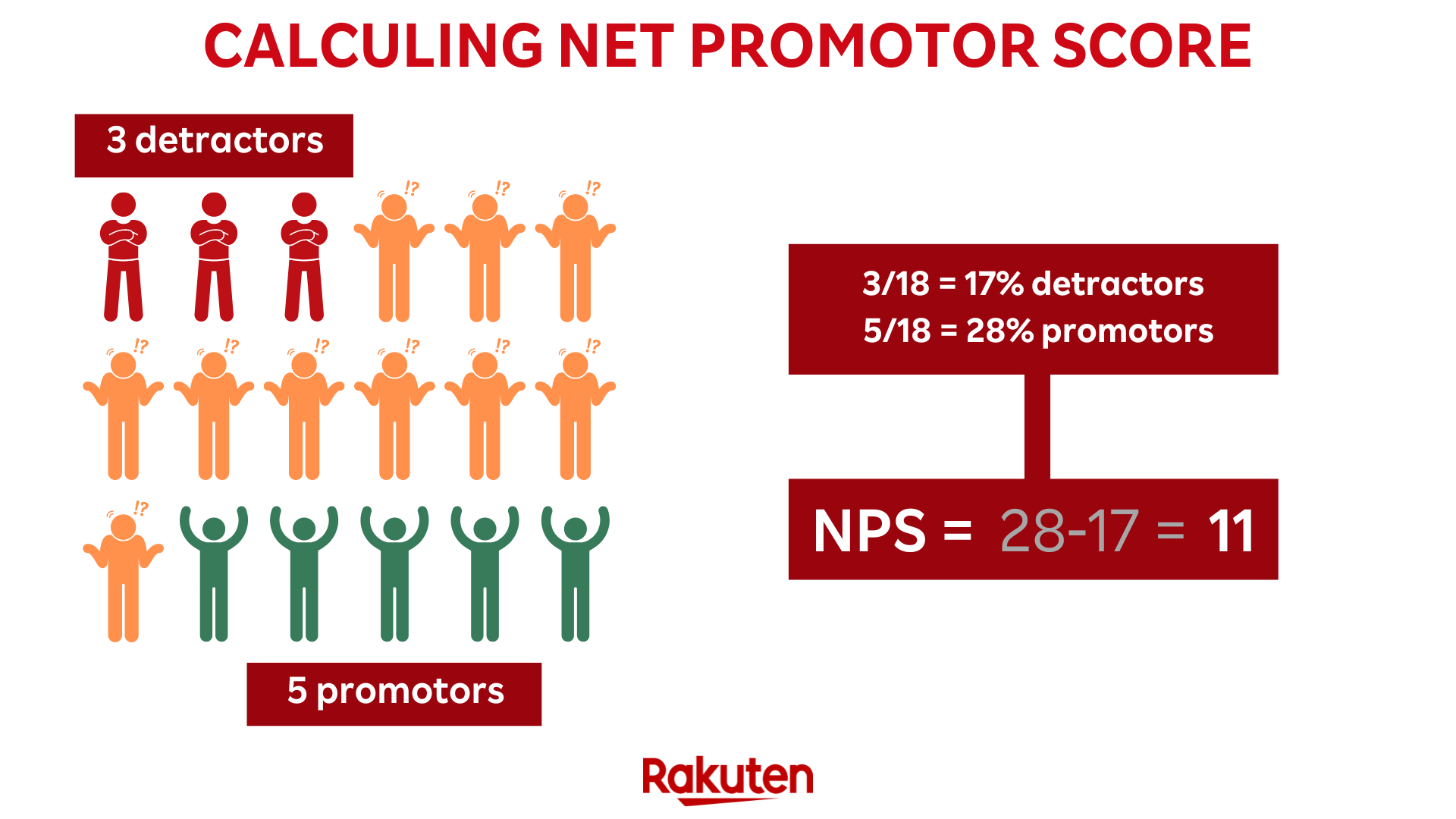
Take advantage of a marketplace’s loyalty programs
Joining a marketplace with an effective loyalty program is an excellent strategy for ensuring customer retention and optimizing your sales over the long term. Becoming a partner of Rakuten and its loyalty program, Club R, is an excellent opportunity for you as a seller. Here are a few figures to prove it:
- 13 million members with a loyal, committed audience who buy regularly.
- Average shopping basket 7 times higher than non-members.
- A 30% higher-than-average re-purchase rate.
- The most generous loyalty program in France, with attractive cashback, exclusive promotions and additional benefits for loyal shoppers.
Why make this choice? Because registering with a marketplace that supports loyalty enables you to achieve 3 objectives: Save time – Increase your sales – Improve your conversion rate. A partnership with Rakuten means you’ll benefit from a program that’s already optimized to maximize your profits and guarantee stable growth.
In conclusion
Building customer loyalty is not an option, it’s a necessity to ensure your success and longevity in the marketplace. There’s no mystery to building customer loyalty in the marketplace: you need to provide quality service, establish a relationship of trust and offer attractive rewards. It’s by implementing an effective strategy that you’ll be able to perpetuate your business and optimize your results. By partnering with a program like Rakuten’s Club R, you can benefit from an engaged audience that will naturally increase your re-purchase rate. This program represents a unique opportunity to maximize your revenues and win the loyalty of an increasingly demanding clientele. Take advantage of it!
Rakuten France now allows Club R members to buy vouchers and gift cards with their kitty
Paris, December 03. At a time when purchasing power remains at the heart of French people's concerns, Rakuten France is continuing its commitment to offering innovative solutions tailored to their needs. The platform now offers the possibility of purchasing gift cards and vouchers. These practical, advantageous and flexible options enable cashback to be used beyond the shopping platform. Thanks to this initiative, Club R members can not only spend their kitty at numerous partners such as Airbnb, Leroy Merlin or IKEA, but also earn cashback on their gift card purchases.
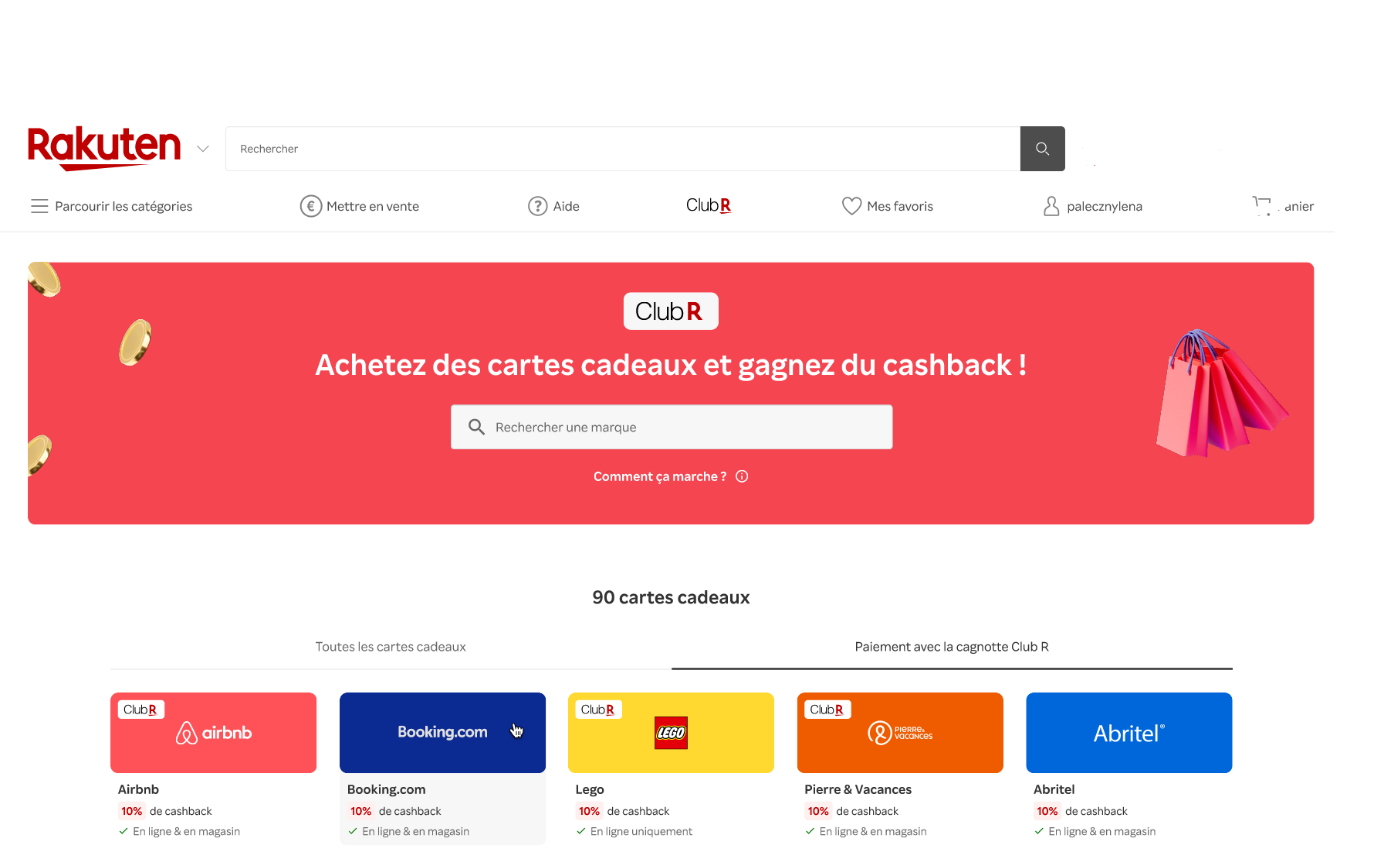
Gift card success: the choice for guaranteed pleasure without breaking the bank over the festive season
Gift cards are a must-have for the festive season. Offering great flexibility to purchasers, they enable them to give pleasure to loved ones without the risk of making a mistake. Increasingly popular, gift cards are set to grow by 8% in 2023, a strong sign that the French are embracing this practical, personalized solution.
A major new feature is that members can now use their Club R kitty - the most generous cashback program in French e-commerce - to purchase gift cards from a wide range of brands, including King Jouet, Marionnaud and Nature & Découvertes, for example, giving them greater flexibility in managing their purchases.
" With this new system, which complements our existing offer, we are making cashback easier to use and reinforcing its impact, to better meet our members' expectations. This reflects our constant desire to support the purchasing power of the French at the end of the year" - says Kevin Delli, Head of e-Merchandising, Brand & Loyalty at Rakuten France.
A solution in line with the expectations of the French, 48% of whom use a cashback program , according to an Ipsos study for Rakuten France.
A stronger cashback offer to boost purchasing power
Rakuten France continues to position itself as a key partner for the purchasing power of the French with this new solution linked to Club R. This free, no-obligation cashback program enables its 13 million members to recoup between 5% and 35% of their purchases on the marketplace, as well as from over 2,000 partners.
By purchasing these vouchers, users can not only treat themselves or their loved ones, but also recoup a portion of their spending in cashback.
" We've seen strong demand for solutions that combine flexibility and purchasing power. Club R's gift cards and vouchers are the perfect answer to this trend, enabling people not only to give pleasure, but also to recoup part of their spending " - explains Armando Pastor, Marketing and C2C Director at Rakuten France.
| How does it work?
Purchasing a gift card via Rakuten is a simple, three-step process:
For example, I buy a Casa gift card worth €100 and pay for part of it (€50) with my cashback. I receive my gift card instantly by email. I get €2.50 (i.e. 5% of the €50 paid by credit card) directly back into my kitty. |
*Buybox study on the 2023 figures for the online gift card market.
Black Friday 2024: Last Key E-commerce Statistics!
Black Friday has become a must-attend event for consumers and retailers in France. Every year, the event attracts increasing interest, with sales figures rising steadily and consumers ever more eager for bargains. This year, new data sheds light on the buying habits of the French. Find out more in this article about the key figures for Black Friday 2024!
Black Friday figures
French more optimistic about their purchasing power
- 49% of French people think their purchasing power will remain stable (11 points compared to 2023), and 13% even hope for an improvement (source: Ipsos for Rakuten France).
Average budget still high
- 388€: that's the average budget per consumer expected to be spent on Black Friday this year (source: Opinionway for Bonial).
A marked interest in bargains
- 59% of French people say they are actively looking for discounts (source: Ipsos for Rakuten France).
- 96% of consumers want to be informed of these offers, and 92% of them want to be informed by digital means: e-mail, banners on websites, online catalogs, etc. (Source: Opinionway).
Increase in online purchases
- Nearly 40% of spending takes place online during Black Friday (versus 21% the rest of the year) (Source: Kantar Worldpanel).
- 42% of French people plan to make their purchases exclusively on the Internet (source: Opinionway for Bonial).
- 53% of online purchases are made from a cell phone (source: Criteo)
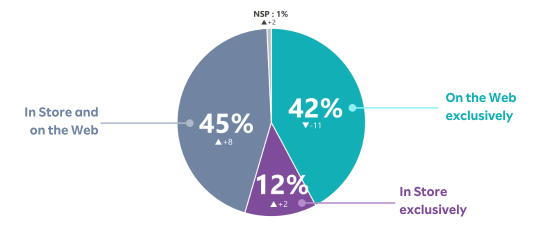
Source: Etude - Les Français et le Black Friday, Opinionway for Bonial, 2024
Shopping in anticipation of the festive season
- More than 8 out of 10 French people plan to do their Christmas shopping on Black Friday. This is particularly the case for young people aged 16 to 34. 92% of them plan to buy on Black Friday, and 46% are already used to it. (Source: Rakuten and Ipsos).
Black Friday at Rakuten
Black Friday is a key event at Rakuten. It's the perfect opportunity for our sellers to boost their sales by reaching the many visitors to the marketplace. And for our customers, it's the perfect time to take advantage of great discounts while collecting maximum cashback.
Since 2018, sales on Rakuten during Black Friday have recorded average annual growth of 7 .3%. A number driven by ever-increasing numbers of customers and an ever-more varied offering. Today, over 200 million new and used products are sold on the marketplace by our 10,000 sellers. Our 15 million monthly visitors are delighted by this wide range of products.
The average shopping basket of our Rakuten customers during Black Friday is also growing, averaging 9 .3% per year. This trend is all the more marked among the 12 million members of our loyalty program, whose average basket is 40% higher than that of non-members.
Among our many categories, Electronics (computers, tablets, smartphones, etc.) was the best performer during the last Black Friday. The Books category (literature, manga, comics, e-books, e-readers...) is in second place.
Consumer expectations for Black Friday 2024
As with previous editions, this year the French are expecting great discounts, a wide choice of products and a smooth online shopping experience. They are particularly attentive to the following elements:
- Price : consumers are looking for the best prices and discounts.
- Product quality: Consumers are looking for quality products and reliable sellers. They pay particular attention to customer reviews.
- Additional offers: immediate promotions or cashback make your products even more attractive.
- Shopping path: a fluid, relatively short shopping path limits cart abandonment and guarantees maximum sales.
- Delivery options: consumers want to be delivered as quickly as possible, and pick up their purchases easily. Consider opting for express delivery to satisfy your most hurried customers. Offering click and collect or relay point delivery can also help you stand out from the competition.
The French compare prices on various online marketplaces, use price comparators and participate in bargain forums to make sure they don't miss out on the best deals.
At Rakuten, our sellers particularly stand out with two types of promotion:
- Discount coupons: for example, €15 free for every €100 purchase or more.
- Cashback with Rakuten Points: for example, 15% back into your kitty, to be used on Rakuten.
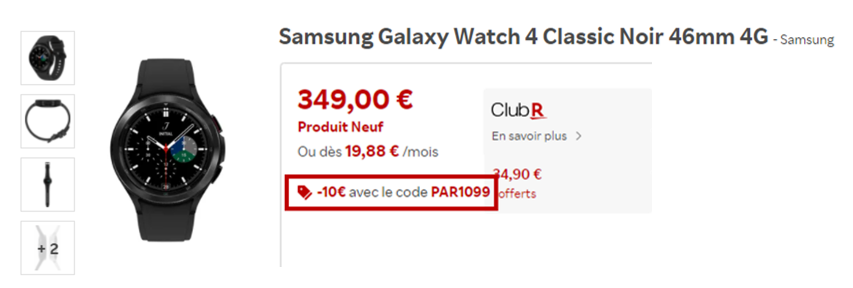
During Black Friday, these promotions can be combined to attract even more customers. If you're a Rakuten seller, talk to your E-Commerce Consultant! He'll help you set up the best promotions for your products and your strategy.
Five mistakes to avoid for a successful Black Friday
- Think sales only: keep your profits in mind. Big discounts can be a real asset, but not if they come at the expense of your margin.
- Not investing in visibility: competition is fierce during Black Friday, and it can be difficult to stand out on marketplaces. Consider investing in services that increase your visibility, such as Rakuten Ads.
- Not taking care of your ads: your product sheets are the first contact consumers have with your brand, and the reflection of the quality of your products. Make sure you take good care of them. Consult our checklist to find out more.
- Not knowing your consumers' expectations: your consumers have clear expectations for Black Friday (in terms of price, desired discounts, etc.). It's particularly important to know the specific expectations of your product category, so that you can position yourself in the best possible way.
- Poor stock anticipation: as you've seen, sales increase significantly during Black Friday. If you run out of stock prematurely, you'll miss out on many opportunities! Remember to check your stocks beforehand. Short on time? Outsource your logistics with a service like Rakuten Fulfillment Network!
